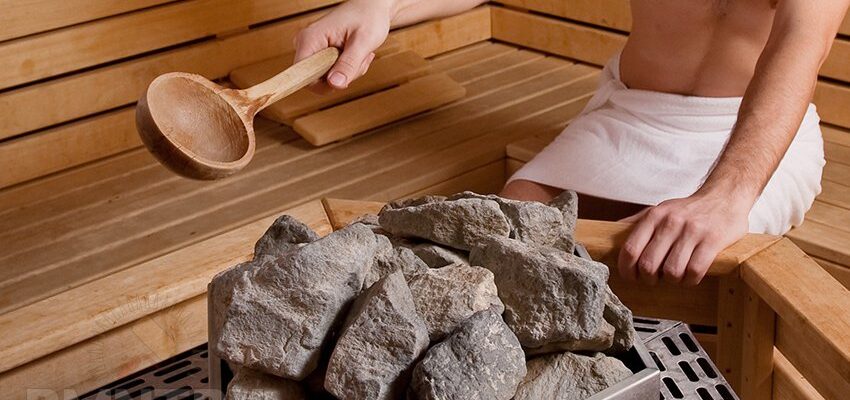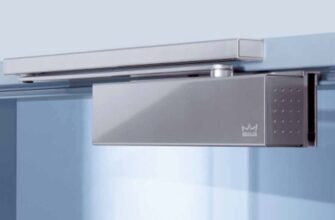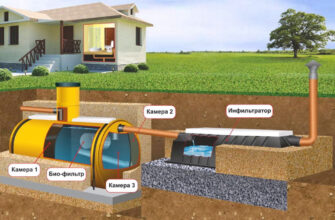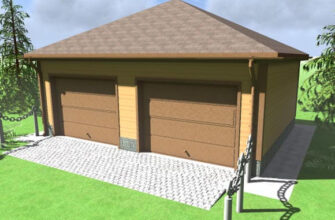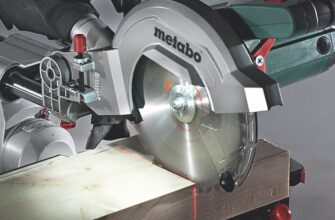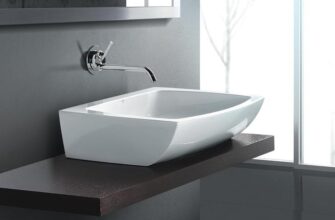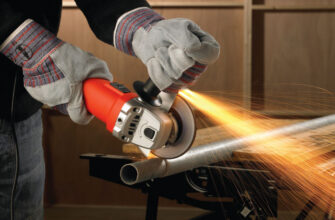A properly designed steam room can be fun. It has a beneficial effect on the body and helps to get rid of ailments. Hot, but environmentally friendly steam is the key to this success. To achieve the desired result, you should choose the right stones for the bath. They will give a pleasant aroma and fill the steam room with useful microelements. In these matters, it is better to rely on the opinion of experienced people and professionals.
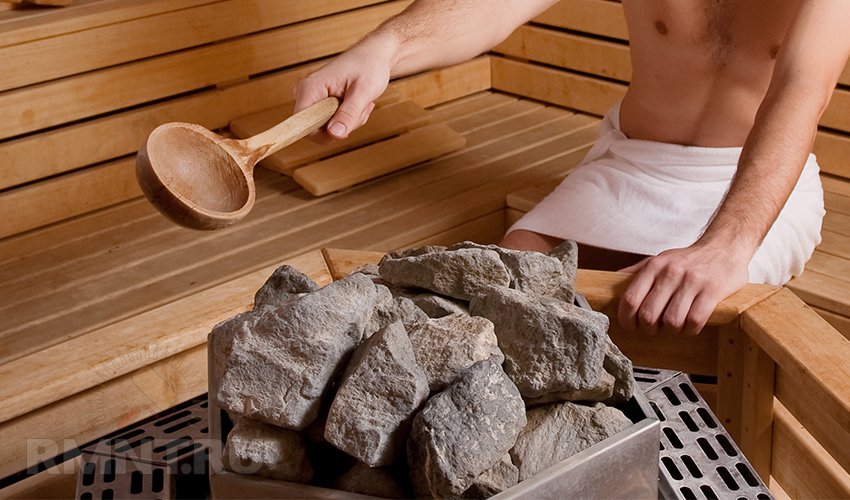
- How to choose stones for a bath, which ones are best for health?
- Types of stones for a bath
- River or sea pebbles
- Advantages
- disadvantages
- Jade
- Advantages
- disadvantages
- Talcochlorite
- Advantages
- disadvantages
- Gabbro-diabase
- Advantages
- disadvantages
- White quartzite
- Advantages
- disadvantages
- Raspberry quartzite
- Advantages
- disadvantages
- Basalt
- Advantages
- disadvantages
- Porphyrite
- Advantages
- disadvantages
- Options for choosing stones for a bath
- What stones for a bath to choose?
- How much do sauna stones cost?
How to choose stones for a bath, which ones are best for health?
The stones help to achieve the desired effect – uniform heating of the room, rich steam and a pleasant aroma. Professionals immediately say that for this you cannot take the first stones that come across.
First of all, they must meet the following requirements:
-
high strength;
-
ability to accumulate heat;
-
resistance to strong heating and sudden changes in temperature;
-
lack of harmful substances and impurities.
One more fact should be added to this – the stones for the bath emphasize the aesthetic appeal of the steam room and become the main decoration of this room.
For the bath, you cannot take the first stones that come across. Cobblestones from the street, when heated, spread an unpleasant odor and substances harmful to the body. In addition, they can simply crumble after a couple of sessions. The usefulness of the bath procedure in this case is reduced to zero.
The stones for the steam room must have a homogeneous structure that does not contain any harmful substances. For these purposes, it is recommended to use several types of minerals that you can find yourself or buy in specialized stores.
Types of stones for a bath
The choice of a particular type of stone depends on personal preference. Professionals do not highlight strict restrictions, but give some recommendations based on specific characteristics and useful properties.
The main types of bath stones:
-
river and sea pebbles;
-
jade;
-
talcochlorite;
-
gabbro-diabase;
-
white quartzite;
-
raspberry quartzite;
-
basalt.
These minerals are suitable for a bath and do the job. They have advantages and disadvantages that should be considered.
River or sea pebbles
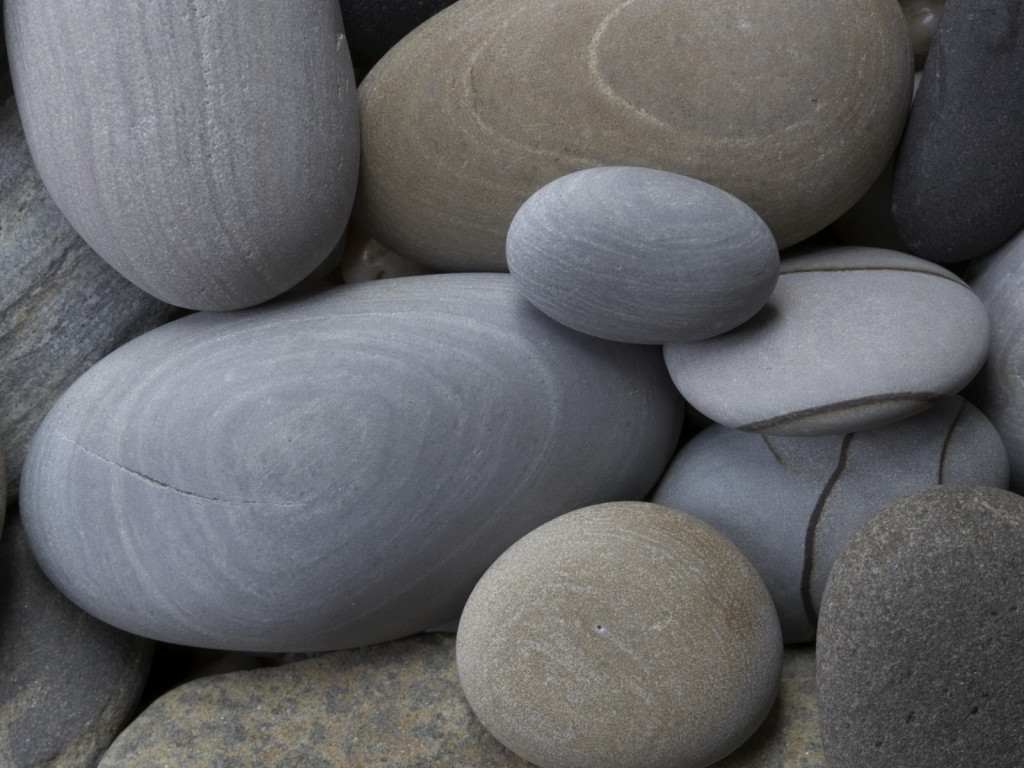
A budget and simple option for a bath, although not bad. Self-collected river pebbles are used in the lower layer on the stove. An oval pebble with a solid structure should be chosen for such purposes.
The slightest inclusions indicate impurities. Red dots indicate the release of iron, which is undesirable in the bath. In addition, when self-collecting, pebbles can be easily confused with river limestone, which negatively affects the body when heated.
Advantages
-
affordable option;
-
good indicators of strength and environmental friendliness;
-
easy to find even on your own;
disadvantages
- it is necessary to carefully select stones.
Jade
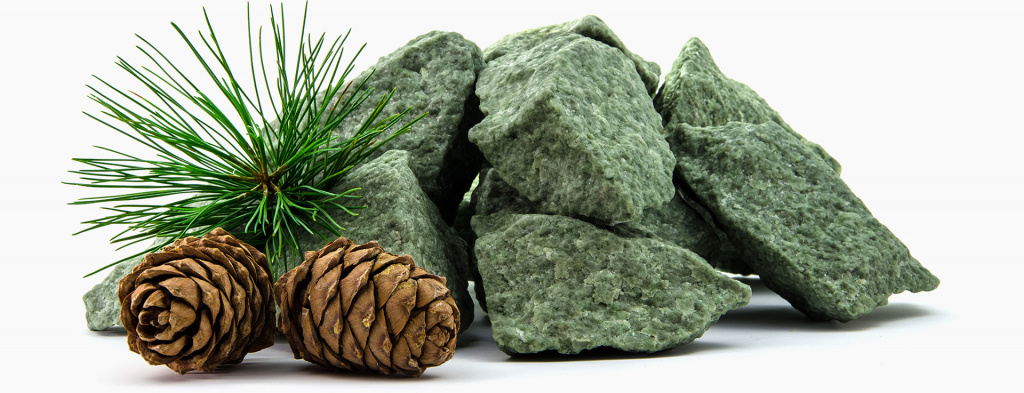
One of the best sauna stones with an attractive emerald hue. It is good for health, and its strength is 2-3 times higher than that of most other bath stones.
Not everyone will find such a stone for a bath. It is used in a chipped form, in a small amount for laying in the top layer on the stove.
Advantages
-
high strength and density, good heat capacity;
-
beneficial effects on the human body;
-
minimal moisture absorption;
-
durability;
disadvantages
- high price.
Talcochlorite
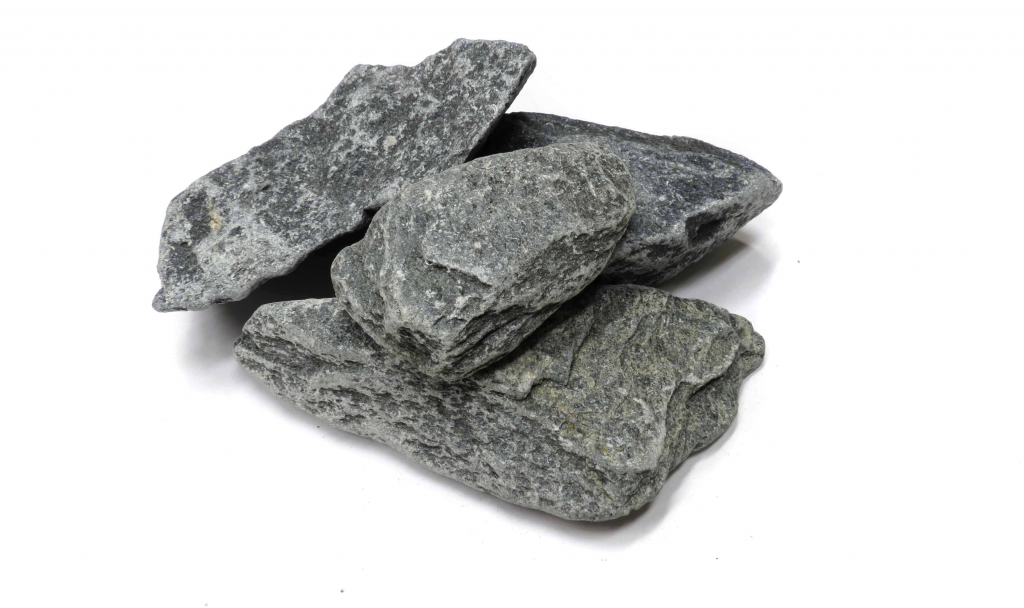
Environmentally friendly mineral, resistant to temperature changes and easy to machine. It is gray in color and not too smooth on the surface. Not everyone likes this appearance, besides, it can 'get dusty'. But talcochlorite is durable and holds heat 2.5 times better than brick.
Such stones are heavy and not very attractive to look at, but they can be used to get clean and healthy steam.
Advantages
-
heat capacity 0.98 kJ / kg K;
-
a large amount of nutrients released during heating;
-
strength and resistance to temperature changes;
-
even distribution of heat in the steam room;
disadvantages
-
prolonged heating;
-
dust emission.
Gabbro-diabase

These stones are considered popular for baths due to their availability and useful qualities. It is obtained mainly in Karelia, which is known for its clean ecology. The stone is dark in color and has a marble-like appearance. But with strong heating, extraneous odors are felt, which is why it is not recommended to use aromatic oils, and over time, gabbro-diabase begins to crumble.
Gabbro-diabase is a good choice for a sauna, but it is better not to use essential oils in such a steam room. In addition, over time, it is required to sort out stones and replace damaged ones.
Advantages
-
ecological cleanliness;
-
affordable cost;
-
therapeutic effect on the respiratory system;
-
good warmth;
-
attractive appearance;
disadvantages
-
prolonged heating;
-
unpleasant odor with strong heat;
-
low strength;
White quartzite
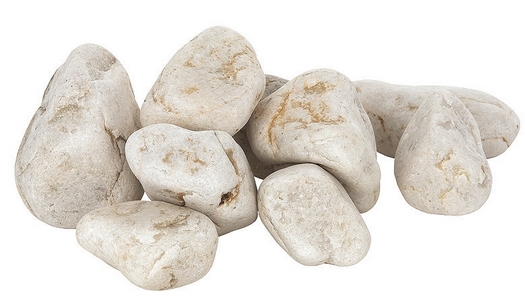
This mineral is popular in certain circles for its specific qualities. It is a light white stone, which contains a large number of oxygen molecules. Because of this, when heated, a slight smell of ozone appears. But it is an expensive mineral, which, moreover, is not very durable.
White quartz is good for the body, it gives off the smell of ozone when heated, but it will have to be changed often. This is one of the most expensive bath stones.
Advantages
-
attractive appearance;
-
ecological cleanliness;
-
anti-aging effect on the body, cleaning the respiratory system;
disadvantages
-
low strength, easily bursts when temperature drops;
-
high price.
Raspberry quartzite
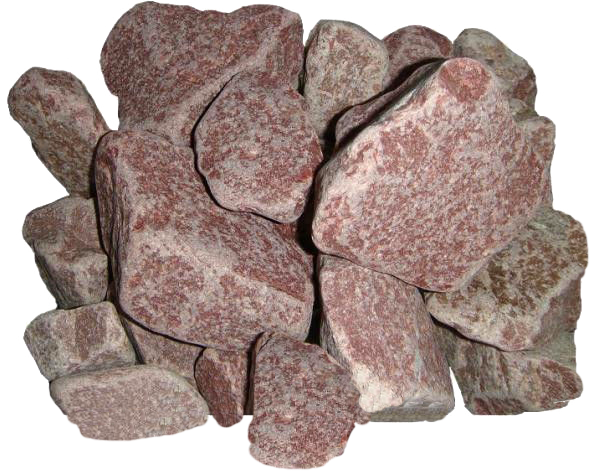
Raspberry quartzite is a valuable, but rare mineral. It attracts with its rich purple color, which is why it is often chosen by professional designers for the design of the steam room. The stone itself is dense and hard, capable of serving for a long time. It does not crack even with strong temperature changes.
Raspberry quartzite is a great option for a bath, although it is not easy to get it. It is stacked in small quantities in the top layer to give the oven an attractive appearance.
Advantages
-
ecological cleanliness;
-
bright and attractive color;
-
fire resistance – up to 2700⁰С;
-
increased mechanical strength, resistance to cracking;
disadvantages
-
the complexity of processing;
-
high price.
Basalt

Basalt is also sometimes called volcanic. It belongs to the category of strong stones for a bath with low water absorption. Volcanic rock accumulates heat and releases it evenly. He is not afraid of either temperature or sharp cooling with cold water. The resulting steam has a healing effect.
This stone is popular because it is inexpensive, durable and environmentally friendly, although not everyone will like the look.
Advantages
-
strength, durability and wear resistance;
-
affordable cost;
-
medicinal properties;
-
good heat capacity and uniform heating;
disadvantages
-
rough appearance;
-
complexity of processing.
Porphyrite
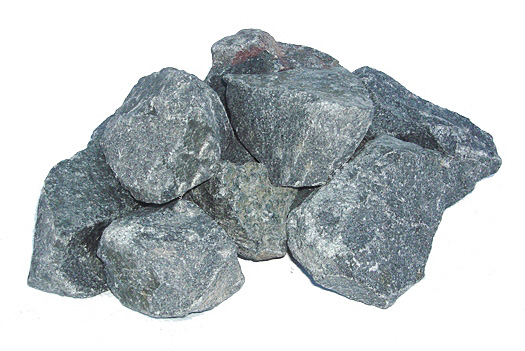
Porphyrite is another volcanic stone that has a gray-black color. When heated, it gives a rich and thick steam that will please avid bath attendants. It maintains warmth well for a long time. Thanks to beneficial trace elements, it has a beneficial effect on the respiratory system.
Volcanic rocks are ideal for bathing. They serve for a long time, are not afraid of temperature changes, but in appearance they are rough and unpresentable.
Advantages
-
relieves headaches, makes breathing easier;
-
serves for a long time and does not crack;
-
accumulates and maintains heat;
disadvantages
- requires periodic cleaning from dust.
Options for choosing stones for a bath
Each mineral has a specific set of qualities that should be guided by when choosing. Professionals distinguish several parameters:
-
strength;
-
heat storage;
-
structure features;
-
appearance;
-
ecological cleanliness.
The stone for the bath must be strong and at the same time keep warm. This is its function, therefore dense and heavy minerals are chosen. Although, in any case, professionals recommend changing them every 3-4 years.
The stone must have a homogeneous structure without inclusions and impurities. Flat stones are preferable in shape, because they lie better on the stove and quickly gain heat. The optimal size is from 50 to 130 mm, but all stones themselves should be approximately the same.
Another parameter is environmental friendliness. When heated, stones should not emit any harmful substances.
What stones for a bath to choose?
For a simple Russian bath in the country or next to the cottage, jadeite or basalt is suitable. They have to be durable and heat-resistant in the first place, because people love to splash water to get steam. He, in turn, should be light and useful.
Any mineral is suitable for a sauna in which no one splashes water on the stove. First of all, you should pay attention to those that retain heat longer. A good option would be soapstone or quartzite.
If there is no traditional stove in the bath, and electric heaters and steam generators are used to maintain the temperature, then the stones serve more for decoration. In this case, raspberry quartzite, porphyrite or marble are recommended.
Depending on the size of the stove, the weight and size of the stones must be taken into account.
How much do sauna stones cost?
-
Available stones for the bath are gabbro-diabases, which cost from 15-20 rubles per kg.
-
Attractive and practical jadeite will cost from 150 to 250 rubles per kg.
-
Raspberry quartzite is offered at a price of about 70-100 rubles per kg.
In the following articles, our experts tell you how to choose a gas water heater and the secrets of choosing a concrete mixer.
Attention! This material is the subjective opinion of the authors of the project and is not a purchase guide.

